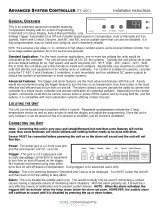
The parameter settings stored in the LCP are now transferred to the frequency converter indicated by the progress bar. When 100% is reached, press
[OK].
2.1.4. Parameter Set-Up
The frequency converter can be used for practically all assignments, thus offering a significant number of parameters. The series offers a choice between
two programming modes - a Quick Menu mode and a Main Menu mode.
The latter provides access to all parameters. The former takes the user through a few parameters making it possible to program the majority of HVAC
applications.
Regardless of the mode of programming, you can change a parameter both in the Quick Menu mode and in the Main Menu mode.
2.1.5. Quick Menu Mode
Parameter Data
The graphical display (GLCP) provides access to all parameters listed under the Quick Menus. The numeric display (NLCP) only provides access to the
Quick Setup parameters. To set parameters using the [Quick Menu] button - enter or change parameter data or settings in accordance with the following
procedure:
1. Press Quick Menu button
2. Use the [▲] and [▼] buttons to find the parameter you want to change
3. Press [OK]
4. Use [▲] and [▼] buttons to select the correct parameter setting
5. Press [OK]
6. To move to a different digit within a parameter setting, use the [◀] and [▶] buttons
7. Highlighted area indicates digit selected for change
8. Press [Cancel] button to disregard change, or press [OK] to accept change and enter the new setting
Example of Changing Parameter Data
Assume parameter
22-60, Broken Belt Function
is set to [Off]. However, you want to monitor the fan-belt condition - non- broken or broken - according
to the folowing procedure:
1. Press Quick Menu key
2. Choose Function Setups with the [▼] button
3. Press [OK]
4. Choose Application Settings with the [▼] button
5. Press [OK]
6. Press [OK] again for Fan Functions
7. Choose Broken Belt Function by pressing [OK]
8.
With [▼] button, choose [2] Trip
The frequency converter will now trip if a broken fan-belt is detected.
Select [My Personal Menu] to display only the parameters, which have been pre-selected and programmed as personal parameters. For example, an AHU
or pump OEM may have pre-programmed these to be in My Personal Menu during factory commissioning to make on-site commissioning / fine tuning
simpler. These parameters are selected in
par. 0-25 Personal Menu
. Up to 20 different parameters can be programmed in this menu.
If [No Operation] is selected in
par. 5-12 Terminal 27 Digital Input
, no connection to +24 V on terminal 27 is necessary to enable start.
If [Coast Inverse] (factory default value) is selected in
par. 5-12 Terminal 27 Digital Input
, a connection to +24V is necessary to enable start.
Select [Changes Made] to get information about:
• the last 10 changes. Use the up/down navigation keys to scroll between the last 10 changed parameters.
• the changes made since default setting.
Select [Loggings] to get information about the display line read-outs. The information is shown as graphs.
VLT
®
HVAC Drive Programming Guide 2. How to Programme
MG.11.C4.02 - VLT
®
is a registered Danfoss trademark
13
2
























